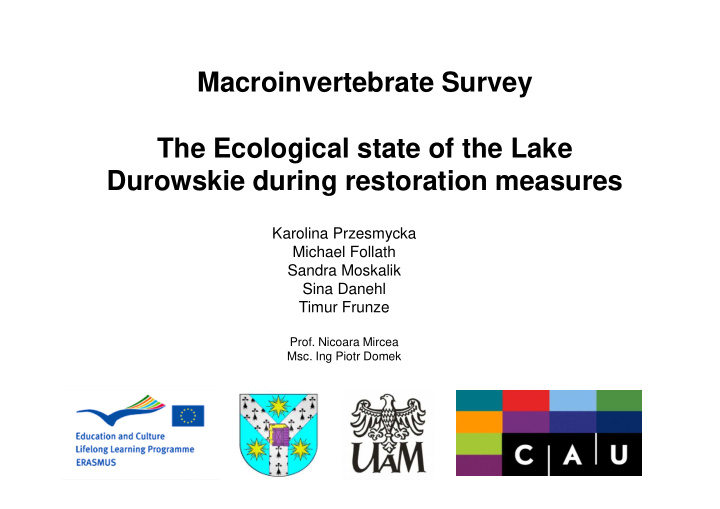



Macroinvertebrate Survey The Ecological state of the Lake Durowskie during restoration measures Karolina Przesmycka Michael Follath Michael Follath Sandra Moskalik Sina Danehl Timur Frunze Prof. Nicoara Mircea Msc. Ing Piotr Domek
Content • Introduction • Material & Methods • Macroinvertebrates found • Data & Data analysis • Discussion & Conclusions
Lake Durowskie
Lake Durowskie Sample Stations Stations Description 1 Littoral with reed near forest cover 2 Littoral near urban area 3 Pelagial near dam 4 4 Littoral near urban area Littoral near urban area 5 Pelagial (Areator I) 6 Pelagial near Struga Golaniecka River 7 Littoral near Camping ground 8 Littoral (Bulrush near forest cover) 9 Pelagial 10 Pelagial (Areator II) 11 Littoral with reed 12 Littoral near urban area 13 Littoral with reed near forest cover 14 Pelagial
Legal background European Water Framework Directive (WFD) � framework for the protection of water bodies bodies � target: 'good ecological quality status' for all water bodies by 2015 � need to identify and to assess pressures and impacts � macroinvertebrates can be used as target organisms
Material and Methods „Kajak” „czapla”
Material and Methods Taking Samples and using sieving device
Material and Methods Sorting, classification, weighting & determination
Macroinvertebrates � > 2 mm � large enough to be seen with an unaided eye � inhabiting all types of freshwater � without a backbone
Macroinvertebrates - Bioindicators � generally abundant � critical part of the lake’s food web � cannot escape pollution & show effects of short- and long term pollution events term pollution events � generally good response to a multitude of stressors � affected by the physical, chemical, and biological conditions � can show the cumulative impacts of pollution � diversity indicates local conditions � relatively easy sampling technique
Macroinvertebrate Orders � Platyhelminthes (Flatworms) � Nematoda (Roundworms) � Oligochaeta (Aquatic worms) Glossiphonia complanata Anodonta anatina � Hirudinea (Leeches) � Gastropoda (Snails) � Gastropoda (Snails) Theodoxus fluviatilis � Unionoida (Clams and Mussels) Sialis fuliginosa � Isopoda (Pill Bugs) � Megaloptera (Dobsonflies / Hellgrammites) Trichoptera sp. � Ephemeroptera (Mayflies) � Trichoptera (Caddisflies) � Diptera (True Flies) Chironomidae larvae Chaoborus flavicans � Acari (Mites and Ticks )
Data analysis The Shannon-Wiener Index is a diversity index with a quantitative measure that reflects how many different species there are in a dataset, and simultaneously takes into account how evenly the individuals are distributed among the species found. proportion of individuals Shannon-Wiener index 2,5 2 2010 1,5 2011 1 2012 2013 0,5 0 1 2 3 4 5 6 7 8 9 10 11 12 13 14
Data analysis Pielou’s species evenness refers to how close in numbers each species in an environment is. J’ is constrained between 0 and 1. The less variation in communities between the species, the higher J’ is. Pielou's species evenness 1 0,9 0,8 0,7 2010 0,6 0,5 2011 0,4 2012 0,3 2013 0,2 0,1 0 1 2 3 4 5 6 7 8 9 10 11 12 13 14
Data analysis The Simpson index is used to measure the degree of concentration when individuals are classified into type. Simpson index 2,5 2 1,5 2010 2011 2012 1 2013 0,5 0 1 2 3 4 5 6 7 8 9 10 11 12 13 14
Data analysis EPT index is an index of water quality based on the abundance of three pollution-sensitive orders of macroinvertebrates. It is calculated as the sum of the number of Ephemeroptera , Plecoptera , and Trichoptera divided by the total number of Chironomidae. The EPT Index increases with improving water quality. EPT Index = Σ (EPT / total # organisms) * 100% EPT EPT 0,6 0,5 0,4 2010 0,3 2011 2012 0,2 2013 0,1 0 1 2 3 4 5 6 7 8 9 10 11 12 13 14
Conclusions � Number of identified taxa with wide number of taxa ecological range continue to increase 40 � adapted to worse conditions 30 20 10 � According to the EPT-Index the species 0 2010 2011 2012 2013 adapted to good water quality are less adapted to good water quality are less abundant � In general the number of species which indicate a good water quality decrease (e.g. no Plecoptera found) while at the same time the new found taxa indicate worse conditions � higher biodiversity ≠ higher quality � The species number in the littoral is higher than in the peligial � Low effiency of the aerators � General trend of all used indices: The quality state of the lake is decreased
Thank you !!!
Recommend
More recommend